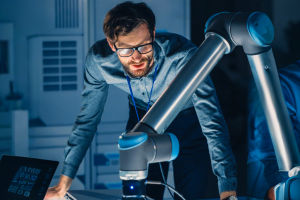We're surrounded by all kinds of smart tech, from voice assistants that tell us the weather to apps that suggest what we might like to watch or buy next. But what's behind all this magic?
Let's dive into it together—what artificial intelligence (AI) really means, how machine learning (ML) fits into the picture, and why it all matters in our daily lives.
What exactly is Artificial Intelligence (AI)?
Artificial Intelligence is basically about creating systems or machines that can act and think like humans. We're talking about machines that can "see" things using cameras, "understand" speech or writing, learn from data, and even make suggestions. In short, AI is about copying the kind of smart thinking we do and getting machines to do it too.
But let's clear one thing up—AI isn't one single piece of tech. It's actually a group of different technologies working together to help a system make decisions, learn, and solve problems in clever ways. It's like the brain behind many tools and apps we use today.
Then, what is Machine Learning (ML)?
Machine Learning is a key part of AI, and it's all about helping machines learn from experience. Imagine showing your computer tons of examples—like photos of cats and dogs—until it figures out how to tell them apart on its own. That's ML in action.
Instead of programming every step, we use algorithms (smart formulas) to feed the machine lots of data. The more data it gets, the better it becomes at spotting patterns and making predictions. What it learns from this process is called a "model"—basically a smart system trained to solve a certain problem.
How are AI and ML connected?
Think of AI as the big idea—like an umbrella—and ML as one of the spokes under that umbrella. AI is the dream of machines being smart like humans, and ML is one of the main tools we use to make that dream come true.
Here's an easy way to remember it:
• AI = smart system doing tasks like humans
• ML = the way we teach machines to get smarter through data
There are other parts under the AI umbrella too, like deep learning, natural language processing, and robotics.
How are they different?
Here's where it gets interesting. AI is focused on solving problems in a "human-like" way—it's about making machines that can reason and make decisions. ML, on the other hand, doesn't worry about being human-like. It's just focused on learning from data to do one specific job really well.
Let's say you ask your smart speaker, "How long will my commute take today?" The system uses AI to understand what you asked and gives you a helpful answer. But behind the scenes, machine learning is used to predict traffic conditions using live road data. The ML model isn't trying to be "smart" in a human way—it's just doing a great job at analyzing traffic patterns.
What makes AI systems unique?
AI systems aim to copy how we solve big, complex problems. They can:
• Think logically
• Learn from experience
• Use data in many forms—whether it's written text, spoken language, images, or charts
• Keep improving as they go
This allows AI systems to work in real-world situations, making decisions even when the data is messy or incomplete.
What makes Machine Learning special?
ML shines when we give it a specific goal—like sorting emails, detecting fraud, or recommending products. Its strengths include:
• Learning from past data
• Making accurate predictions
• Getting better over time
• Handling structured and semi-structured data (like spreadsheets or form inputs)
But unlike AI, it doesn't handle unstructured data (like full articles or videos) as well without help from other tech.
Why combine AI and ML?
When we use both AI and ML together, we unlock a lot of cool possibilities for businesses and organizations. Here are just a few perks:
• Bigger data reach: We can pull in and understand more types of information—from numbers and charts to written feedback and photos.
• Faster decisions: Systems become quicker and smarter, helping us act on useful insights in less time.
• Higher efficiency: Less time spent on manual tasks means more time for creative thinking.
• Better tools for people: We can plug smart predictions right into business reports and apps, giving workers a serious productivity boost.
Where do we see AI and ML in real life?
Let's look at some familiar areas where these technologies are making a difference:
Healthcare
Helping doctors by analyzing patient records, predicting outcomes, assisting in diagnosis, speeding up drug discovery, and even tracking health over time.
Manufacturing
Keeping an eye on factory machines, predicting when equipment needs fixing, and improving workflows with IoT sensors.
Online Shopping
Personalized product suggestions, smart search tools, demand forecasting, and smooth supply chain management.
Banking and Finance
Detecting fraud, automating routine tasks, and helping customers faster with smart service systems.
Telecom
Optimizing network performance, automating upgrades, and spotting service issues before they become real problems.
So Lykkers, what does this mean for us?
It means we're stepping into a world where everyday tools and services are becoming smarter and more helpful. Whether we're chatting with a virtual assistant, shopping online, or seeing better services at the doctor's office—it's all powered by the smart combo of AI and ML.
Got a new idea or curious about how this tech can help you? Let's chat! The more we understand it, the better we can use it to make life smoother and smarter.
Want to see how this tech works in your field or daily life? Drop your thoughts, Lykkers—we'd love to hear from you!


